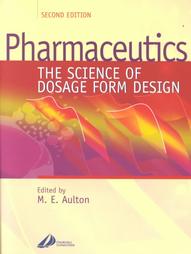Defensins are a group of antimicrobial and cytotoxic peptides made by immune cells. There are seven defensins in humans, six alpha-defensins and one beta-defensin, which are involved in the innate immune defense at the surface of epithelia from the respiratory tract, the intestinal tract or the urinary tract.
Pharmacology Dictionary
Pharmaceutics: The Science of Dosage Form Design: Edited by M.E. Aulton
A comprehensive textbook covering the design of dosage forms and all aspects of drug delivery systems. ‘Pharmaceutics’ in its broadest sense is the ‘art of the apothecary’ or, in simple terms, pharmaceutical preparations. It remains a diverse subject in the pharmacy curriculum, encompassing design of drugs, their manufacture, and the elimination of micro-organisms from the products. This books encompasses all those areas and pays particular attention to the design of dosage forms and their manufacture.
Choroideremia
Disorder characterized by atrophy of the choroid (the thin membrane covering most of the posterior of the eye between the retina and sclera) and degeneration of the retinal pigment epithelium resulting in night blindness. The disease is caused by mutations in Rab escort protein Rep1 (component A of Rab geranylgeranyl transferase).
Chorionic Gonadotropin
Chorionic gonadotropin (CG) is produced in the placenta. Together with the pituitary hormones, luteinizing hormone (LH) and follicle-stimulating hormone (FSH), it constitutes the glycoprotein family of gonadotropins. The actions of CG are mediated by the LH receptor, both belonging to the superfamily of G-protein Coupled Receptors.
Cholecystokinin
Cholecystokinin (CCK) is produced in the intestine and the brain. It appears to be an important mediator of anxiety.
- It also stimulates vasopressin secretion and slows gastric emptying.
- In addition, it is an important humoral satiety signal (appetite control).
- Various antagonists have been developed and are currently being investigated with regard to their therapeutic potential.
Chemotherapy
Treatment for tumor patients with synthetic drugs – chemotherapeutics – that may be of completely different chemical structure.
The main goal of tumor chemotherapy is to achieve a selective toxicity for the tumor without causing damage to the host, for instance by combining several cytostatic drugs at doses lower than required for monotherapy.
Chemoreceptor Trigger Zone
The chemoreceptor trigger zone (CTZ) is a group of neurons in the area postrema of the medulla. Once stimulated, it activates the vomiting center, which is also located in the medulla, thereby causing emesis.
- The CTZ is sensitive to a variety of chemical stimuli.
- Syrup of ipecac (synonym ipecacuanha) and apomorphine are direct stimulators of the CTZ.
- Clinically they are used to provoke emesis after oral ingestion of a poison.
- The CTZ is also stimulated by other drugs, e.g. cardiac glycosides, morphine (opioid system) and antineoplastic agents.
Cheese Reaction
Hypertensive reaction resulting fromrelease of noradrenaline by tyramine and other sympathomimetic amine as a consequence of irreversible inhibition of MAO-A.
Caveolae
Caveolae are invaginations of the plasma membrane. They contain the protein caveolin and are rich in certain phospholipids. Similar to coated pits, they bud off internally forming endocytic vesicles. Caveolae play an important role in the internalization of certain cell surface receptors.
Causalgia
Causalgia is burning pain evoked by the activation of sympathetic efferent fibres. The likely mechanism underlying this syndrome involves ectopic expression of α-adrenoceptors on nociceptive afferents following peripheral injury or disease.

